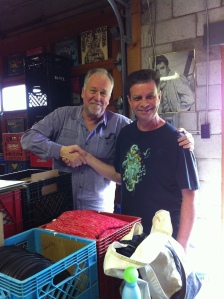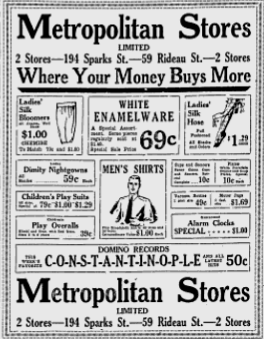| Lew Stone |
| Birth name |
Louis Steinberg |
| Also known as |
Lew Stone |
| Born |
1898
London, England, UK |
| Died |
1969
Roehampton, London, England, UK |
| Genres |
British Dance Band, Jazz |
| Occupations |
Bandleader |
| Instruments |
Piano |
| Associated acts |
Nat Gonella & His Georgians |
Lew Stone (1898-1969) was a bandleader and arranger of the British dance band era, and was well known in Britain during the 1930s.
Early life and career
Stone learned music at an early age and became an accomplished pianist. In the 1920s, he worked with many important dance bands. Some arrangements attributed to Stone can be heard on particular records by the Savoy Orpheans (1927) and Ray Starita and his Ambassador’s Band (1928).
During 1927-1931, Stone’s arrangements for the Bert Ambrose Orchestra made it virtually the best in Europe. The HMV discs are today sought after as much for those arrangements as for the superb instrumentalists or vocals.
Stone continued to work with other bands like Jack Hylton‘s and Jack Payne‘s BBC Dance Orchestra, and he also took several top musicians into the studio to make a few recordings that were issued on the Duophone label as ‘Stoneis Stone and his Orchestra’.
The 1930s
Roy Fox‘s Band opened at the Monseigneur Restaurant in 1931 and Stone took up the position of pianist and arranger. When Fox became ill in October he was sent to Switzerlandto rest and Stone assumed leadership of the band. The main vocalist at the Monseigneur was the very popular Al Bowlly who had already sung on over 30 recordings.
Stone began to use other band members for vocal refrain and this proved successful, particularly when trumpeter Nat Gonella sang “Oh! Mo’nah”. Sales of the record Decca F.2763 were huge and may have kept Decca in business[citation needed].
When Fox returned to London in April 1932, he found that his band was the most popular in the city. A contemporary article in The Gramophone magazine described events.
In 1932, Stone also worked with a studio band and several recordings were issued on the flexible Durium Records featuring vocals by Al Bowlly, Sam Browne and Les Allen. Some of the arrangements on Durium were by Stan Bowsher.
In October 1932, when Roy Fox’s contract at the Monseigneur ended, Stone was offered the post of bandleader and this story filled the pages of the music press. An article fromRhythm magazine describes how this happened.
The Tuesday night broadcasts from the Monseigneur established Stone’s band as a great favourite with the listening public, who recognised the sheer quality of the music, and the royal clientele attracted an unsurpassed reputation. Rave reviews were common in the music press, for example Melody Maker.
The popularity of vocalist Al Bowlly increased; he was a regular on broadcasts, his name was credited on many of the Decca records and he toured with the band including an appearance before of royalty at the London Palladium.
There is a very good cartoon of Stone’s Band with Al Bowlly at the microphone and the other musicians from the band of 1933 are: Nat Gonella and Alfie Noakes (trumpets), Stone Davis and Joe Ferrie (trombones), Joe Crossman, Jim Easton, Ernest Ritte, Harry Berly (reeds), Eddie Carroll (piano), Harry Sherman (guitar), Tiny Winters (string bass) and Bill Harty (drums). Some arrangements were by Phil Cardew, Stan Bowsher, Con Lamprecht.
In 1933, Stone’s Monseigneur Band was involved in an interesting competition designed to test the popularity in Britain of British vs US dance bands. It was run by the ‘News Chronicle‘ newspaper and was based on the sales of specially recorded dance tunes by Stone’s band, Jack Hylton’s, Guy Lombardo‘s and Wayne King‘s. The songs were “What More can I Ask?” and “Can’t We Meet Again?”.
From late 1931 until 1934, Stone was also musical director for British and Dominion Films, working mostly from Elstree Studios, and later worked with other film companies. About 40 pre-1947 films which involved Stone with his band or as Musical Director are included in the listings of British musical films on the British Dance Bands on Film, British Entertainers on Film, British Musical Directors website.
In November 1933, Stone transferred his band to the Cafe Anglais and in February 1934 started a very successful tour for the Mecca Agency. The band returned to the Monseigneur in March 1934 until the summer when the Monseigneur was sold to become a cinema. In September 1934, Al Bowlly and Bill Harty left to join Ray Noble in USA.
For about a year from November 1934, Stone moved to the Regal Zonophone record label, continued with theatre tours, and the band was resident for a time at the Hollywood Restaurant. Alan Kane became the main vocalist while there were also vocal contributions from Nat Gonella, Joe Ferrie, Tiny Winters and Joe Crossman. When Gonella left to concentrate on his own Georgians band in March 1935, trumpeter Tommy McQuater joined Stone’s band. On October 12,, Stone featured Sam Browne as vocalist for the first time with “Cheek To Cheek” and Isn’t This A Lovely Day?. In November, Stone and his band returned to the Decca record label.
In 1936, Stone stopped touring and formed a smaller band which opened on 30 March at the Cafe de Paris. The band also began to broadcast regularly for commercial radiostations Radio Normandy and Radio Luxembourg. In October, Stone became musical director for the show On Your Toes (opened February 1937). The band continued at the Cafe de Paris until 31 July 1937. In September, Stone became musical director of the show Hide and Seek at the London Hippodrome starring Cicely Courtneidge and Bobby Howes.
Al Bowlly returned to England at the end of 1937 and in February 1938 he began recording with Stone again. Recordings with Bowlly in 1938 are as good as those made during the earlier years. Stone’s band played music of all kinds, for all tastes, and for all the dance tempos, but today it is particularly their playing of the sentimental ballads that is recognised and in demand for re-issue on CD, especially the titles featuring Bowlly. In his own arrangements, Stone was particularly careful to match Bowlly’s voice with appropriate ensemble phrasing and short instrumental solos resulting in very pleasant recordings which make much more satisfying listening than many other bands’ recordings of the standard tunes.
Stone was not afraid to work with modern music and was also an innovator. His recordings of the Gene Gifford/Casa Loma Orchestra titles are not mere copies but careful interpretations which make full use of the superb musicians in his band. The skills of Stone Davis, Joe Crossman and Nat Gonella are particularly evident on several of Stone’s earlier jazz titles, some of which were issued in USA.
In June 1938, the band was the first name band to play at Butlins Holiday Camps and in September they were back at The Cafe de Paris and broadcasting regularly from there.
In October, Stone became musical director for the Jack Hulbert show Under Your Hat which continued into 1939 and featured the Rhythm Brothers (Clive Erard, Jack Trafford, Frank Trafford). His band played at the El Morocco Club, London.
The 1940s & 1950s
In June 1940, Stone opened at the Dorchester Hotel with a seven piece band which he led on the novachord. This band was much praised for its original style. Later Stone also made several records with his jazz group the Stonecrackers which featured Britain’s finest soloists. Broadcasting and recording with his large band continued and he toured the country during the rest of the war years.
After the war, his band resided at various places including The Embassy Club, The Pigalle Restaurant and Oddenino’s Restaurant up to 1955. In this period he made several recordings with the King of Jiddish Music Leo Fuld. Stone continued to work round the ballrooms and broadcast with his fourteen piece band until 1959 when the BBC told him that he could not expect to broadcast as frequently as he would wish unless he reduced the size of his band. So, Lew Stone and his sextet was born.
The 1960s
For the next eight years they played frequently for ‘Music While You Work’ also appearing weekly, for nearly two years in ‘The Bands Played On’- a breakfast-time programme. Lew was also concentrating on his entertainments agency in the 1960s.
At the time of his death in 1969 Stone’s music from the 1930s was just beginning to gather a whole new following.






































































































